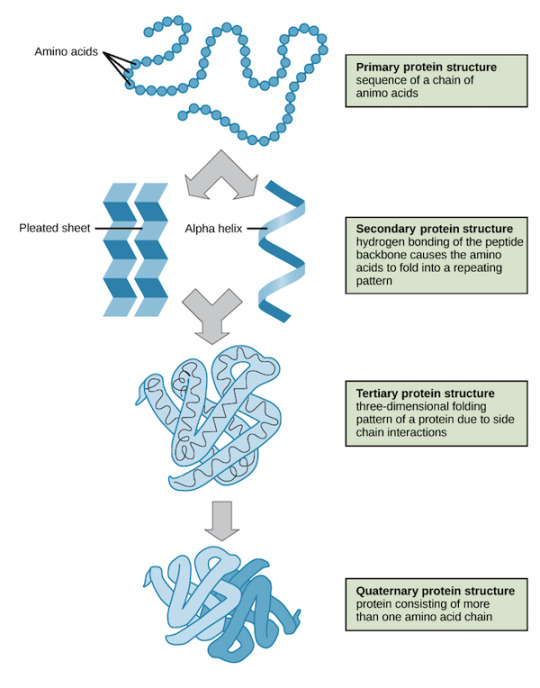#enzyme inhibitors
Note
Can you explain to me the chemistry behind the denaturation of enzymes and the process of allosteric and competitive inhibition?
First of all it's important to understand what an enzyme is. An enzyme is a protein, that catalyses reactions after binding to a substrate and then converts it or splits it.
An enzyme has a very specific shape so it can bind to the substrate, it's like a key and a lock. The substrate binds to the binding site, and in the catalytic or active centre the reaction takes place.
This is important to understand denaturation: Proteins are made out of amino acids that are bound with peptide bonds. Proteins have several levels of structure: Their primary level is the sequence of amino acids, the secondary structures are folded structures due to interactions of the peptide backbones via hydrogen bonds, like alpha helices or beta sheets.
The tertiary structure is folding of the peptides due to electrochemical interactions between different amino acids. Amino acids can have different charges due to their side chains, they can be positive, negative or neutral charged. So those charges will either attract or repel each other, putting the peptide chain in a certain three dimensional shape or conformation.
In the quaternary structure several peptide chains come together to create a bigger functional unit (the enzyme) made out of subunits, they often also interact with ions (cofactors) as their catalytic centre where the catalysed reaction takes place.
All those levels create the specific shape of the enzyme that is required to bind to their target substrate. So if those structures are changed in any way, it won't work anymore because it can't bind.
Just reading it probably makes it difficult to understand, so here's a textbook graphic.

This shape can be changed by denaturation. A protein can be denaturated by heat, or changed pH or high salinity and other not optimal conditions. During those conditions like changed pH the interactions between the molecules and side chains do not work anymore because pH can change the charges of the sidechains, so secondary, tertiary and quarternary structures will be changed. When those structures are changed the binding site will change too and not resemble the lock anymore where the key substrate can bind, so now the enzyme is inactivated/inhibited.
Enzymes can also be inhibited (or activated) by regulatory molecules binding to the enzyme, inhibitors or activators.
This can be a competitive inhibition, when the inhibitor binds at the same binding and active site and blocking it, making the actual substrate that should be processed unable to bind there. Like a lock that already has a key stuck in it, you can't put another key in there.
Allosteric inhibition is when the inhibitor binds at another site, not directly at the active site where the substrate binds. But by binding to the allosteric site the conformation of the enzyme gets changed by chemical interactions, changing the binding site so the substrate doesn't get recognised anymore. A key can't be insterted into a lock that has been changed.
Inhibtion can be irreversible (making the enzyme dysfuntional for the rest of it's existence until it is degraded) or reversible.
#roleplay#rp#sherlock roleplay#sherlock rp#sherlock#sherlock holmes#biology#molecular biology#biochemistry#chemistry#a level chemistry#chemblr#bioblr#science#scientist#scienceblr#biology student#biology facts#a level biology#enzyme inhibitors#protein#molecular biology enzymes#science side of tumblr#studying#biology studyblr#chemistry major#biology major#college#university#sherlock replies
26 notes
·
View notes
Text

Maximum Muscle, Nerve & Energy Support!
#health and wellness#healthy living#health lifestyle#body builders#energy booster#enzyme inhibitors#dietary supplement
0 notes
Text
Dehydrating nuts and seeds
Why would anyone dehydrate nuts and seeds when they’re already tasty raw? Some people with digestive issues find that soaking and dehydrating nuts and seeds make them easier to handle. That’s because raw nuts contain enzyme inhibitors. Soaking helps break down these inhibitors, making nuts and seeds more digestible.
To prepare nuts for dehydrating, soak overnight in a solution of salt and water (about 1 tablespoon sea salt to 4 cups of nuts covered in water). Drain and spread in a single layer on dehydrator trays. Dry at 145 F for 12 to 24 hours. This recipe works well for cashews, almonds, pecans, walnuts, and pumpkin seeds.
[snipped from larger article about dehydrating foods at https://learn.eartheasy.com/]
1 note
·
View note